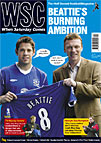 Mike Ticher recalls Arsenal's first championship – the same season that saw Manchester Utd relegated
Mike Ticher recalls Arsenal's first championship – the same season that saw Manchester Utd relegated
The long-term significance
Arsenal’s first League title (and the first by any southern club) set them on their way to their domination of the 1930s. The previous year’s FA Cup final victory over manager Herbert Chapman’s old club, Huddersfield, was neatly symbolic, but the championship cemented the north Londoners’ arrival. It had taken Chapman six years to win it, but then the floodgates opened, with three in a row from 1933-35, another in 1938 and a second Cup win in 1936 – though he didn’t live to see most of the silverware, having died in 1934.
Story of the season
Arsenal won four of their first seven games by 4-1 and looked the only possible winners after beating their nearest challengers, Aston Villa, 5-2 on November 8 – a defeat compounded by Villa’s 6-4 home defeat by Derby the following week. Villa won the return against Arsenal 5-1 in March, but by then it was too late. In the second-highest scoring season in top-flight history, there were any number of eye-popping results. Leeds United contrived to be relegated despite beating Blackpool 7-3, Middlesbrough 7-0 and Man Utd 5-0. Man Utd’s bewildered defence let in 49 goals as they lost their first 12 games, starting 4-3, 3-1, 6-0, 6-2, 7-4. Blackpool, who stayed up thanks to a 2-2 draw with Man City on the last day, somehow shipped even more goals than United (125), including a 10-1 defeat at Huddersfield in December.
For the record books
Arsenal’s 66 points were six better than the previous best in League history. Villa smashed Sheffield Wednesday’s First Division scoring record of 105, set the previous season – in their home matches alone, Villa scored 86. Tom “Pongo” Waring grabbed 49, a club record. Newcastle’s record crowd (68,386) saw their beloved striker Hughie Gallacher return with his new team, Chelsea, in the second match of the season. Meanwhile, in the Third Division South, the lowest ever League attendance – 469 – huddled in the vast West Ham greyhound stadium to see Thames beat Luton 1-0 on December 6.
Same place today
Only Arsenal have stayed in the top flight without interruption since then, but 13 of the 22 First Division teams are now in the Premiership. Everton were Second Division champions in their first year below the top level and won the League title the following season.
Moved furthest away
It all seems a long time ago for fourth-rung Grimsby, who enjoyed one mad spell of matches that ended 5-3, 4-3, 3-5, 4-1, 3-4, 3-5, while Blackpool, Huddersfield and Sheffield Wednesday are a division above.
Went on to greater things
The World Cup ~ Inaugurated in the summer of 1930, though not important enough for England to enter until 1950.
Cliff Bastin ~ Already Arsenal’s youngest scorer, he became their youngest scorer of a hat-trick (at 18) in a 6-3 win over Derby on February 14, then all-time leading scorer until Ian Wright.
Bill Shankly ~ Starting his career with the Ayrshire junior side Cronberry Eglinton.
Stanley Matthews ~ On the books of Stoke as a 15-year-old, though he did not make his debut until March 1932.
Disappearing from view
Alex Jackson ~ “The Gay Cavalier” was one of three big-money signings for newly promoted Chelsea (£8,500 from Huddersfield), but after only two seasons he left League football altogether, moving to the US via non-League Ashton Nationals.
Frank Barson ~ Reputedly the most hated man in 1920s football, the former Villa and Man Utd hard man marked his last League appearance, for Wigan Borough, by being sent off on Boxing Day against Accrington Stanley. Borough themselves gave up the ghost after 12 games of the following season.
From WSC 216 February 2005. What was happening this month